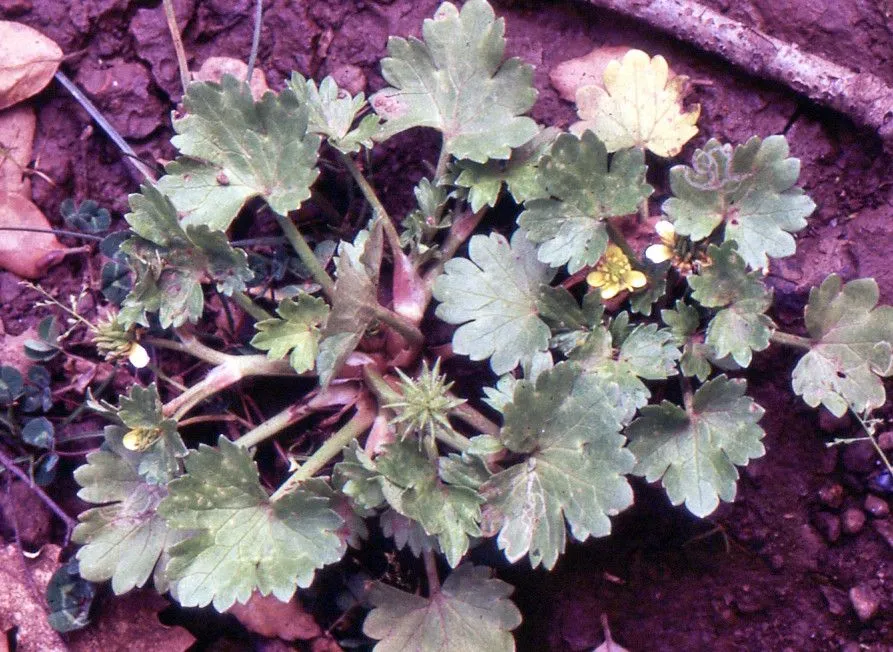
Author: L.
Bibliography: Sp. Pl.: 555 (1753)
Year: 1753
Status: accepted
Rank: species
Genus: Ranunculus
Vegetable: False
Observations: Medit. to C. Asia and W. Himalaya, Arabian Pen.
Bur buttercup, known scientifically as Ranunculus muricatus, is a member of the Ranunculaceae family. This intriguing plant was first documented by the renowned botanist Linnaeus in his seminal work “Species Plantarum” in 1753.
The natural habitat of bur buttercup spans from the Mediterranean region to Central Asia and Western Himalaya, extending its reach into the Arabian Peninsula. This geographical distribution speaks to the plant’s adaptability and resilience in various climates and terrains.
Characterized by its unique morphology, bur buttercup is easily distinguishable. Its small, yellow flowers and distinctive seed pods contribute to both its aesthetic appeal and its common nomenclature. Typically found in fields, open spaces, and disturbed soils, Ranunculus muricatus thrives in environments that range from temperate to slightly arid.
As a member of the Ranunculaceae family, bur buttercup shares common traits with its relatives, including the presence of curly or prickle-like fruits, which can sometimes cause skin irritation upon contact. Despite this, it remains a significant species for study due to its unique ecological and biological attributes.
In summary, Ranunculus muricatus – or bur buttercup – stands out as a fascinating plant with a rich history and a wide native range, offering numerous intriguing facets for botanists and plant enthusiasts alike.
Dan: pigget ranunkel
Spa: ranunculo centella
Eng: rough-fruited buttercup, spinyfruit buttercup, bur buttercup, prickle-fruit buttercup, rough-fruit buttercup, sharp buttercup, sharp crowfoot, sharp-fruit buttercup, sharp-point crowfoot, scilly buttercup, spiny-fruited buttercup, spiny fruited crowfoot
Deu: stachelfrüchtiger hahnenfuß
Swe: taggsmörblomma
Nld: stekelboterbloem
Cym: blodau-ymenyn ffrwythau garw, blodyn-ymenyn ffrwythau garw, crafanc pigffrwyth
En: Bur buttercup, Sharp buttercup, Sharp crowfoot, Sharp-fruit buttercup, Sharp-point crowfoot, Rough-fruit buttercup, Prickle-fruit buttercup, Rough-fruited Buttercup, Spinyfruit buttercup, Scilly Buttercup, Spiny-Fruited Buttercup, Spiny fruited crowfoot, Spiny Buttercup
Da: Pigget ranunkel
Nl: Stekelboterbloem
Fr: Renoncule à petites pointes, Renoncule muriquée, Pied-de-coq
De: Stachelfrüchtiger Hahnenfuß
He: נורית הזיזים
It: Ranuncolo spinoso
Ja: Togemi-no-kitsune-no-botan
Sk: Iskerník mäkkoostňový
Es: Ranunculo centella, Abrepuños, Abrojos a cinco, Abrojos a cuatro
Sv: Taggsmörblomma
Cy: Blodau-Ymenyn Ffrwythau Garw, Blodyn-Ymenyn Ffrwythau Garw, Crafanc Pigffrwyth
Taken Oct 13, 2021 by Mr Miags (cc-by-sa)
Taken May 16, 2017 by Pierre Bonnet (cc-by-sa)
Taken Apr 12, 2021 by Llandrich anna (cc-by-sa)
Taken Mar 15, 2018 by Osetya Polat (cc-by-sa)
Taken Mar 28, 2017 by Nina Kirkman (cc-by-sa)
Taken Oct 13, 2021 by Mr Miags (cc-by-sa)
Taken Jan 25, 2022 by jeremy taylor (cc-by-sa)
Taken Sep 9, 2020 by Michelena Valentina (cc-by-sa)
Taken Apr 12, 2021 by Llandrich anna (cc-by-sa)
Taken Mar 28, 2017 by Nina Kirkman (cc-by-sa)
Taken May 16, 2017 by Pierre Bonnet (cc-by-sa)
Taken May 16, 2017 by Pierre Bonnet (cc-by-sa)
Taken Apr 12, 2021 by Llandrich anna (cc-by-sa)
Taken Apr 12, 2021 by Llandrich anna (cc-by-sa)
Taken Apr 13, 2019 by margarida vila (cc-by-sa)
Taken May 10, 1999 by Tela Botanica − Liliane Roubaudi (cc-by-sa)
Taken Apr 8, 2011 by Tela Botanica − Geneviève Botti (cc-by-sa)
Taken May 8, 2016 by Tela Botanica − Liliane ROUBAUDI (cc-by-sa)
Taken Apr 8, 2022 by Monteiro Henrique (cc-by-sa)
Taken Mar 30, 2014 by Tela Botanica − Paul FABRE (cc-by-sa)
Taken May 11, 2019 by Llandrich anna (cc-by-sa)
Taken Apr 15, 2004 by Photoflora – Benoit BOCK (©)
Taken Apr 15, 2004 by Photoflora – Benoit BOCK (©)
Taken Mar 26, 2021 by Silvia Domínguez (cc-by-sa)
Taken Feb 11, 2021 by Torres Pedro (cc-by-sa)
Taken Apr 15, 2008 by Photoflora – Benoit BOCK (©)
Taken Apr 24, 2014 by Tela Botanica − Liliane Roubaudi (cc-by-sa)
Taken Apr 24, 2014 by Tela Botanica − Liliane Roubaudi (cc-by-sa)
© copyright of the Board of Trustees of the Royal Botanic Gardens, Kew.
© copyright of the Board of Trustees of the Royal Botanic Gardens, Kew.
© copyright of the Board of Trustees of the Royal Botanic Gardens, Kew.
Growth habit: Forb/herb
Ph maximum: 5.5
Ph minimum: 5.0
Light: 9
Atmospheric humidity: 8
Bloom months: [‘apr’, ‘may’, ‘jun’]
Soil nutriments: 3
Family: Myrtaceae Author: (F.Muell.) K.D.Hill & L.A.S.Johnson Bibliography: Telopea 6: 402 (1995) Year: 1995 Status:…
Family: Rubiaceae Author: Pierre ex A.Froehner Bibliography: Notizbl. Bot. Gart. Berlin-Dahlem 1: 237 (1897) Year:…
Family: Sapindaceae Author: Koidz. Bibliography: J. Coll. Sci. Imp. Univ. Tokyo 32(1): 38 (1911) Year:…
Family: Asteraceae Author: A.Gray Bibliography: Pacif. Railr. Rep.: 107 (1857) Year: 1857 Status: accepted Rank:…
Family: Fabaceae Author: Medik. Bibliography: Vorles. Churpfälz. Phys.-Ökon. Ges. 2: 398 (1787) Year: 1787 Status:…
Family: Aspleniaceae Author: (Cav.) Alston Bibliography: Bull. Misc. Inform. Kew 1932: 309 (1932) Year: 1932…